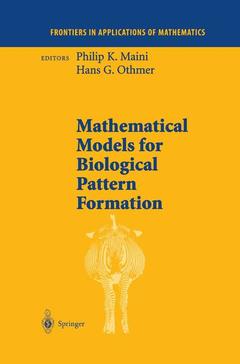Mathematical Models for Biological Pattern Formation, Softcover reprint of the original 1st ed. 2001 Frontiers in Applications of Mathematics Series
Langue : Anglais

This 121st IMA volume, entitled MATHEMATICAL MODELS FOR BIOLOGICAL PATTERN FORMATION is the first of a new series called FRONTIERS IN APPLICATION OF MATHEMATICS. The FRONTIERS volumes are motivated by IMA pro grams and workshops, but are specially planned and written to provide an entree to and assessment of exciting new areas for the application of mathematical tools and analysis. The emphasis in FRONTIERS volumes is on surveys, exposition and outlook, to attract more mathematicians and other scientists to the study of these areas and to focus efforts on the most important issues, rather than papers on the most recent research results aimed at an audience of specialists. The present volume of peer-reviewed papers grew out of the 1998-99 IMA program on "Mathematics in Biology," in particular the Fall 1998 em phasis on "Theoretical Problems in Developmental Biology and Immunol ogy." During that period there were two workshops on Pattern Formation and Morphogenesis, organized by Professors Murray, Maini and Othmer. James Murray was one of the principal organizers for the entire year pro gram. I am very grateful to James Murray for providing an introduction, and to Philip Maini and Hans Othmer for their excellent work in planning and preparing this first FRONTIERS volume. I also take this opportunity to thank the National Science Foundation, whose financial support of the IMA made the Mathematics in Biology pro gram possible.
Biological pattern formation — a marriage of theory and experiment.- Spatiotemporal pattern formation in early development: A review of primitive streak formation and somitogenesis.- Mathematical modeling of vertebrate limb development.- Models for pigment pattern formation in the skin of fishes.- Generic modelling of vegetation patterns. A case study of Tiger Bush in sub-Saharian Sahel.- Chemical Turing patterns: A model system of a paradigm for morphogenesis.- Beyond spots and stripes: Generation of more complex patterns by modifications and additions of the basic reaction.- Spatiotemporal patterning in models of juxtacrine intercellular signalling with feedback.- Modelling Dictyostelium discoideum morphogenesis.- Modeling branching and chiral colonial patterning of lubricating bacteria.- Modeling self-propelled deformable cell motion in the Dietyostelium mound; a status report.- A minimal model of locomotion applied to the steady gliding movement of fish keratocyte cells.- Computer simulations of mechanochemical coupling in a deforming domain: Applications to cell motion.- List of workshop participants.
Date de parution : 09-2012
Ouvrage de 327 p.
15.5x23.5 cm
Date de parution : 10-2000
Ouvrage de 327 p.
15.5x23.5 cm
Thème de Mathematical Models for Biological Pattern Formation :
© 2024 LAVOISIER S.A.S.
